| Ken Sakamura |
 |
|
 |
 |
 |
|
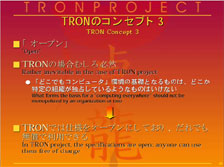
Slide 26
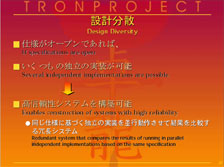
Slide 27
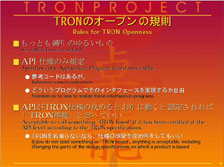
Slide 28
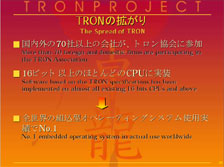
Slide 29
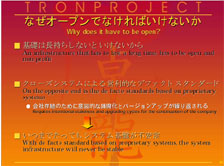
Slide 30
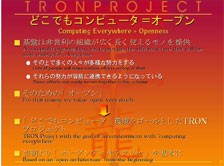
Slide 31
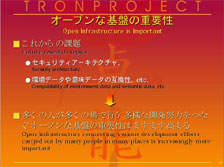
Slide 32 |
But the
biggest theme of the TRON project is "openness" - and this is the
theme that was selected by this year's award. In fact, in the case
of TRON this is inevitable. Becoming the infrastructure for the
Computing Everywhere environment means becoming the infrastructure
for many people's living environments. It wouldn't do to have an
architecture that is proprietary to a specific organization. The
TRON specification is totally open, and available to anyone free
of charge.
Slide 27 - Design Diversity
Anyone is free to create products or conduct business based on this standard. People are of course also free to create and distribute free software. The effect of an open specification is slightly different from that of open source. Different people and organizations can create more than one source from the same specification. In fact, many different products have been developed from ITRON, meant for embedding in devices. This can be used to build the highly reliable systems relating to the backbones of society. For example, if there is only one implementation, then if that implementation has a mistake in it, no matter how many devices you have they are all going to commit the same error. In contrast, if several implementations are developed based on the same specification, then run in parallel, it is possible to build a more reliable system by eliminating the devices that malfunction. This is the highly reliable development method proposed by TRON, which we call design diversity.
Slide 28 - Rules for TRON Openness
When you actually take a close look at so-called open systems, you will find restrictions on their openness. I think that TRON is the least restrictive of any of them. When all is said and done, TRON is nothing more than an API specification - an API is a collection of interfaces that operate system functions needed when programming an application. While source code is available as a reference, the user is free to realize our specification using any program they like. All TRON decides is a certification standard, which states whether a product can carry the TRON name. If the API is certified to operate in accordance with the TRON specification, the system may be called "TRON compliant." The TRON association also helps with registration on the list and distribution. Conversely, if the specifications differ, it must not bear the TRON name. This is the only limitation that I control.
Just as you are free to implement the TRON specification however you see fit, you are also free to distribute your implementation free of charge, or sell it. There is no obligation to publish the source code. You are also free to tweak the TRON specification for your own purposes - just so long as you do not use the TRON name. This is what I mean when I say that TRON is the loosest open standard. The OS of an embedded system is usually modified, and in these cases the API specification itself usually incorporates some of the company's own know-how. This is why TRON has no general public license (GPL) rule, requiring the source to be submitted in the case of modifications.
VP02 Company name rolling subtitles
VP03 Compatible processor list
Slide 29 - The Spread of TRON
Partly because of this, over 70 firms in Japan and many other countries are actively involved with the TRON association.
And since we make no restrictions on what microprocessors can be used, a great many implementations have been made on a great many microprocessors. The API has been implemented on almost all CPUs that are 16 bits and above. Unlike PCs, cost limitations and performance requirements of embedded applications inevitably lead to a diversification of hardware environments. This has lead to the standardization of OS-external specifications, facilitated education and the creation of educational materials, increased development efficiency, and contributed to the growth of devices with embedded microprocessors.
As a result of this, today TRON is used in many devices, including automotive engine control, car navigation systems, faxes, laser printers, and digital cameras. In particular, recently TRON has been used quite often in cell phones. In terms of numbers, TRON has become the world's most-used embedded operating system. In this sense, I feel that the TRON project has accomplished its goal of improving development efficiency by standardizing specifications for device-embedded OSs.
Slide 30 - Why does it have to be open?
I believe the question of why an infrastructure system needs to be open will be touched upon in the next talk, so here I would just like to bring up one point. Namely, the system must be open - that is to say, non-profit - precisely because the infrastructure must have a long shelf life.
There is no doubt that in many senses, standardization is vital for the development of a computer system. But if that system is achieved as a for-profit de facto standard using a closed system, the company that owns the system will start a cycle of intentionally making older systems obsolete, in order to force people to upgrade. This is because, since software never "goes bad," if you don't intentionally make it obsolete then demand will become saturated, and you will lose your source of revenue. And in order to continue this cycle, you have got to be able to change your specification at will, and keep other companies from creating compatible systems. Upgrading is also related to the intention to create a situation where the competitors can't keep up with you. While this may have benefits for hardware manufactures, because it creates demand to trade up to higher-performance machines, and for publishers of how-to books aimed at users who can't keep up with the upgrades, society as a whole suffers.
In these circumstances, the system infrastructure will never stabilize. New security holes are also constantly created, and there is no doubt that viruses will be created to exploit them. Since a stable software library cannot be built, system builders cannot lower the final cost of their software applications. For example, the market for products to support people with disabilities will always be small, and so people are put in a bind whenever the OS is upgraded.
Slide 31 - Computing Everywhere = Openness
In this situation, the system can't take over the infrastructure of people's overall living environments. That is why so many people are involved in so many efforts to allow non-profit organizations to offer infrastructure that can be used widely and for a long time. And it has now become possible for these efforts to link up with each other. That is what being open is for. And that is why the TRON project, whose goal was the Computing Everywhere environment, advocated the open architecture from the very beginning. We are proud to have been a pioneer in this sense.
Slide 32 - Open Infrastructure is Important
Microprocessors are advancing at an incredible rate. They keep getting smaller and cheaper, until now they are not only being embedded in home electronics and device controllers; today, computers are being embedded in everything making up our environment. I believe that we are close to the Computing Everywhere environment. A great many research topics still remain for the ubiquitous computing environment, however, including the compatibility of security architecture and environmental expression data with meaning data. This will probably make an open infrastructure even more vital, in order to link the diverse efforts of the many people working in many different locations. |
|
|